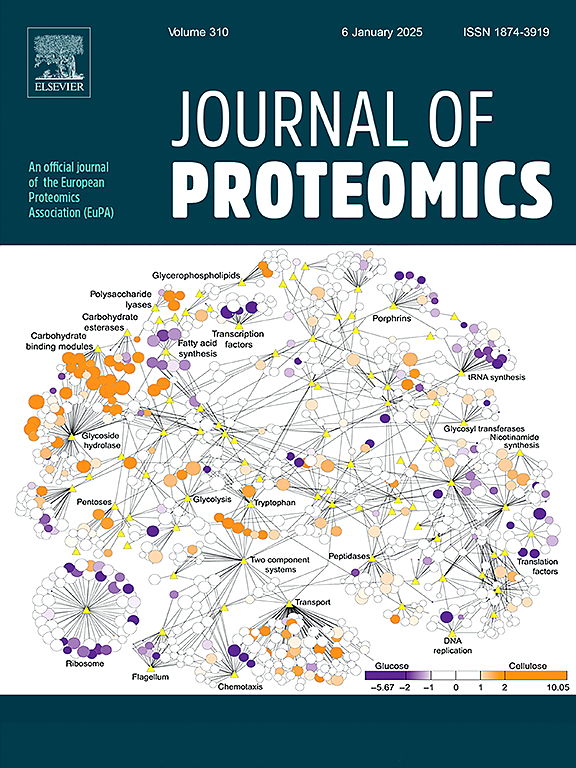Detection and identification of highly antigenic proteins from cytoskeleton of Toxoplasma gondii by immune-proteomics
IF 2.8
2区 生物学
Q2 BIOCHEMICAL RESEARCH METHODS
引用次数: 0
Abstract
Research on the immunogenic molecules of Toxoplasma is a key priority in the development of protective vaccines against the parasite. In the present study, we analyzed the profile of immunorecognized proteins from the Toxoplasma cytoskeleton using sera from patients with both acute and chronic toxoplasmosis. The immunorecognized spots were analyzed by mass spectrometry and characterized by bioinformatic methods, leading to the identification of a total of 313 proteins. Sixty-three antigenic proteins were recognized by IgM antibodies and 250 antigenic proteins were recognized by IgG antibodies. About 10 proteins specifically reported as cytoskeletal proteins were identified with the IgG antibodies while 9 cytoskeletal proteins were detected by IgM antibodies. Bioinformatic analyses of the identified antigenic proteins were performed to determine their immunogenic potential, including the number of epitopes recognized by B lymphocytes, cytotoxic T lymphocytes (CD8+), and helper T lymphocytes (CD4+) receptors. This analysis enabled the selection of highly immunogenic proteins, which could serve as potential candidates for the design of a future vaccine against toxoplasmosis.
Significance
The study of immunogenic molecules from Toxoplasma gondii is a key priority in the search for protective vaccines. Despite partial success in previous strategies, identifying immunogenic proteins from the T. gondii cytoskeleton using immune-proteomics and bioinformatic approaches is crucial for vaccine development. This study provides valuable data that could serve as the foundation for designing novel immunogenic and immunoprotective molecules against toxoplasmosis.

刚地弓形虫细胞骨架中高抗原蛋白的免疫蛋白质组学检测与鉴定
弓形虫免疫原性分子的研究是开发针对弓形虫的保护性疫苗的关键优先事项。在本研究中,我们分析了急性和慢性弓形虫病患者血清中弓形虫细胞骨架的免疫识别蛋白谱。利用质谱法和生物信息学方法对免疫识别点进行分析,共鉴定出313种蛋白质。63种抗原蛋白被IgM抗体识别,250种抗原蛋白被IgG抗体识别。IgG抗体鉴定出10种特异性细胞骨架蛋白,IgM抗体鉴定出9种特异性细胞骨架蛋白。对鉴定的抗原蛋白进行生物信息学分析,以确定其免疫原性潜力,包括B淋巴细胞、细胞毒性T淋巴细胞(CD8+)和辅助T淋巴细胞(CD4+)受体识别的表位数量。这一分析使我们能够选择高度免疫原性的蛋白,这些蛋白可以作为设计未来弓形虫病疫苗的潜在候选蛋白。刚地弓形虫免疫原性分子的研究是寻找保护性疫苗的关键优先事项。尽管以前的策略取得了部分成功,但利用免疫蛋白质组学和生物信息学方法从弓形虫细胞骨架中鉴定免疫原性蛋白对疫苗开发至关重要。本研究为设计新型弓形虫病免疫原性和免疫保护性分子提供了有价值的数据基础。
本文章由计算机程序翻译,如有差异,请以英文原文为准。
求助全文
约1分钟内获得全文
求助全文
来源期刊

Journal of proteomics
生物-生化研究方法
CiteScore
7.10
自引率
3.00%
发文量
227
审稿时长
73 days
期刊介绍:
Journal of Proteomics is aimed at protein scientists and analytical chemists in the field of proteomics, biomarker discovery, protein analytics, plant proteomics, microbial and animal proteomics, human studies, tissue imaging by mass spectrometry, non-conventional and non-model organism proteomics, and protein bioinformatics. The journal welcomes papers in new and upcoming areas such as metabolomics, genomics, systems biology, toxicogenomics, pharmacoproteomics.
Journal of Proteomics unifies both fundamental scientists and clinicians, and includes translational research. Suggestions for reviews, webinars and thematic issues are welcome.
 求助内容:
求助内容: 应助结果提醒方式:
应助结果提醒方式:


